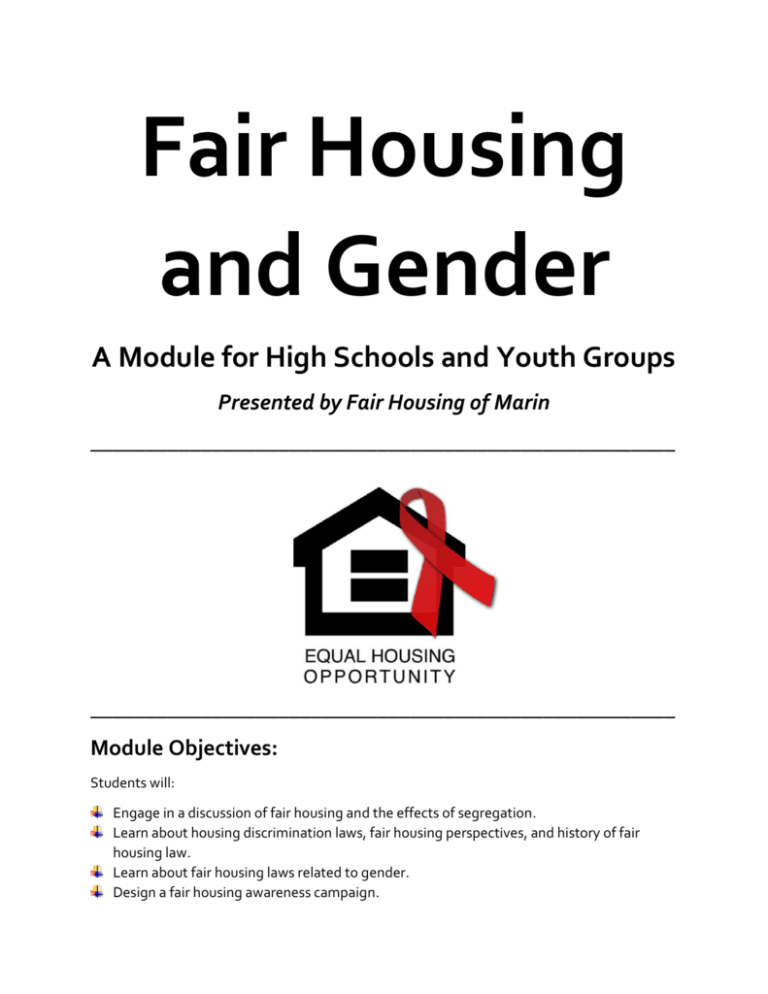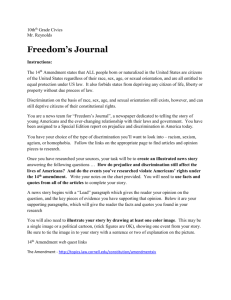
Fair Housing
and Gender
A Module for High Schools and Youth Groups
Presented by Fair Housing of Marin
_____________________________________________________
_____________________________________________________
Module Objectives:
Students will:
Engage in a discussion of fair housing and the effects of segregation.
Learn about housing discrimination laws, fair housing perspectives, and history of fair
housing law.
Learn about fair housing laws related to gender.
Design a fair housing awareness campaign.
PART ONE
LET’S TALK ABOUT HOUSING
DISCRIMINATION
_______________________________________________________________________________
INTRODUCTION
Let’s Explore
Class Discussion
What does the word “home” mean to you?
What is discrimination?
What does housing discrimination look like?
Have you heard real stories of discrimination?
What is a protected class?
What is segregation?
What are the effects of segregation?
Perspectives
Where you live affects every area of your life, your school, your health options,
your employment opportunities, your friendships and neighbors, and your lifestyle. Unfortunately, some people can’t choose where they live, due not only to
economic reasons but to housing discrimination.
Housing equality promotes diversity and integration. Housing discrimination
affects our neighborhoods and our communities and promotes segregation,
which eventually widens wealth inequality.
THE FACTS
What Are Fair Housing Laws?
The United States is a melting pot with people from
different colors, cultures, religions and ethnicities. But for
some people of diverse backgrounds, people with
disabilities, or families with children, it is sometimes
difficult to find a place to live due to discrimination.
Fair Housing laws protect your right to live where you
choose, and require landlords to treat all tenants and
potential tenants equally.
What Are the Protected Classes Covered Under
Fair Housing Law?
Fair Housing laws prohibit housing discrimination based on:
Race
Color
Gender
Religion
National Origin
Disability
Familial Status (minor children)
The State of California has additional protections based on:
Sexual Orientation
Source of Income
Marital Status
Age or other arbitrary reasons
What Activities Are Prohibited?
Based on the fair housing protected classes, it is illegal to:
Refuse to rent, lease or sell most types of housing.
Represent that housing is not available when it is.
Set different terms, conditions or privileges for housing or for use of housing facilities.
Provide different levels or quality of housing services.
Refuse to make reasonable accommodations or modifications to allow a person with a
disability to live in a unit.
Refuse to rent to families because they have children, unless the property meets the
criteria for senior housing.
Enforce rules for some tenants only.
Advertise in a discriminatory manner.
Could It Be
Discrimination
Clues of Possible Discrimination
Discrimination is not usually blatant. Here are some clues that could indicate housing
discrimination:
The story you are told in person is different from the information given on the phone.
The housing provider says, "It is rented” but the vacancy sign remains up or the
newspaper ad continues to appear.
You are told, "You wouldn’t like it here; why don’t you try another apartment complex
where you might feel more comfortable?”
You are told: “We don’t rent to children because the balcony and stairs are unsafe.”
The provider takes your application and says she will call you after references are
checked, but she does not contact you.
You are told that you cannot install a wheelchair ramp or other accessibility
modifications.
You are told, "We don’t allow more than 3 people in a two bedroom unit."
PART TWO
LET’S TALK ABOUT
GENDER AND HOUSING
_______________________________________________________________________________
INTRODUCTION
Let’s Explore
Class Discussion:
How do you define gender?
How can housing discrimination happen based on gender?
What is domestic violence?
What is sexual harassment?
Definitions
Gender: Assigned at birth.
Sexual Orientation: Who you are attracted to romantically or sexually.
Gender Identity: A person’s internal sense of being male or female not
stereotypically associated with the person’s assigned sex at birth.
LGBT: Lesbian, gay, bisexual, transgender.
Sexual Harassment: Housing providers or neighbors making unwanted sexual
advances or entering a tenant’s home without notice.
What Does Gender Discrimination Look Like?
A landlord refuses to rent to a gay couple or
transgender person.
A landlord evicts a female tenant who is a
victim of domestic violence.
A lender refuses to make a mortgage loan to a
woman applicant on maternity leave until she
returns to work.
A maintenance man makes unwelcome
comments to a female tenant or touches her
without consent.
Did You Know?
Recent studies have shown a growing trend towards discrimination in the housing market
against those who identify themselves as gay, lesbian, or transgender.
Many LGBT youth are kicked out of their homes or leave because of lack of family
acceptance of their LGBT identities.
THE FACTS
Fair Housing Law Protections Based on Gender
Sexual Orientation and Gender Identity
Federal law does not explicitly prohibit discrimination on the basis of sexual orientation in
market-rate housing, but California state law does prohibit such discrimination.
“The Equal Access Rule” prohibits discrimination based on sexual orientation, gender
identity, and marital status in all housing that is financed or insured by the U.S.
Department of Housing and Urban Development.
Domestic Violence
“The Violence Against Women Act” protects survivors of domestic violence who live in
federally-subsidized housing. Housing providers can’t deny housing or evict a tenant
because she or he is a victim of domestic violence.
Sexual Harassment
State and federal laws prohibit housing providers from subjecting tenants to sexual
harassment, or retaliating against tenants for refusing sexual advances.
PART THREE
TAKING ACTION
____________________________________________________________________
CLASS PROJECTS
Small Group Discussion
Get together with your classmates or friends and discuss the following questions. Write
down the main points in your discussion and share them with your class.
How can housing discrimination affect your
family?
What are the community benefits of
housing equality?
What can we do to help promote diversity
in our schools and neighborhoods?
How can we help stop gender
discrimination, including sexual
harassment and domestic violence?
How can we bring community awareness of
fair housing issues, including gender
discrimination?
Fair Housing Awareness Campaign
Fair housing protections are essential to our community well-being, and public awareness
is essential. Help us build community awareness in your school and neighborhood.
Addressing General Fair Housing Protections
Interview a victim of housing discrimination, write an article, and publish it on social media.
Interview a victim of housing discrimination and make a short movie. Publish your movie
on social media.
Write a Public Service Announcement on housing discrimination and distribute it to your
local media outlets.
Design an ad or flyer. Distribute the flyer in your school or other groups.
Do a short skit for your school or social studies class depicting scenarios of housing
discrimination.
Write a poem or essay about housing discrimination and how it affects our community and
neighborhoods, and share with your class.
Addressing Gender Related Protections
Write an article for your school newspaper on gender
discrimination.
Make a presentation to your school clubs on gender
discrimination.
Join your school’s straight/gay alliance.
Describe or write scenarios of possible stories of
discrimination based on gender. Share these stories
with your school groups.
Other Ideas?
Do you have other ideas? Talk to your teacher and fellow students about your idea for a fair
housing awareness campaign.
APPENDIX A*
A JOURNEY THROUGH HISTORY
Important Events in the History of Fair Housing Legislation
___________________________________________________________
At the Federal Level
1966
As part of the Chicago Freedom Movement, Dr. Martin Luther King presented a list
of demands to end discrimination in housing. Dr. King acknowledged this campaign
as only ‘‘the first step in a 1,000-mile journey.”
1968
The Fair Housing Act was signed into law. After Dr. King was assassinated, the
national tragedy helped President Lyndon Johnson build congressional support for
the passage of the act. The act prohibited discrimination in the sale, rental, and
financing of housing because of race, color, religion, and national origin. In 1974, sex
was added as a protected class.
1988
The Fair Housing Amendments Act of 1988 was signed into law, adding protection
from discrimination because of disability and familial status. The amendments also
strengthened the Department of Housing and Urban Development’s authority to
enforce the law.
1994
The Violence Against Women Act (VAWA) was signed. Since 1994, VAWA's focus
has been expanded from domestic violence and sexual assault to also include dating
violence and stalking.
At the California State Level
1959
The Fair Employment Practices Act (FEPA) was signed, which prohibited
discrimination in employment on the basis of race, religion, color, national origin, and
ancestry.
1963
The legislature passed the Rumford Fair Housing Act, prohibiting housing
discrimination in rental properties on the basis of race, color, religion, national origin
and ancestry.
1980
The FEPA and the Rumford Fair Housing Act were combined and renamed the Fair
Employment and Housing Act (FEHA), to protect Californians from both
employment and housing discrimination. The FEHA provided broader protections
than its federal counterparts.
1999
The California Civil Rights Amendments of 1999 was signed, adding sexual
orientation to the categories of discrimination prohibited under the FEHA.
FAIR HOUSING OF MARIN
____________________________________________________________________
(415) 457-5025 TDD: (800) 735-2922
www.fairhousingmarin.com
San Rafael, California
Se habla español
Fair Housing of Marin’s mission is to ensure equal housing opportunity and to
educate the community on the value of diversity in our neighborhoods.
Contact Fair Housing of Marin (FHOM) if you feel you are experiencing housing
discrimination, need help with a reasonable accommodation (for people with
disabilities), want to prevent a foreclosure, or need pre-purchase education.
Also, contact FHOM if your group is interested in receiving fair housing
education, or participating in the free Poster Contest or Storyteller programs
for schools and children’s groups.
This high school curriculum is produced, distributed
and copyrighted by Fair Housing of Marin.
*A portion of the content on “Appendix A” was provided by the
National Fair Housing Alliance.






